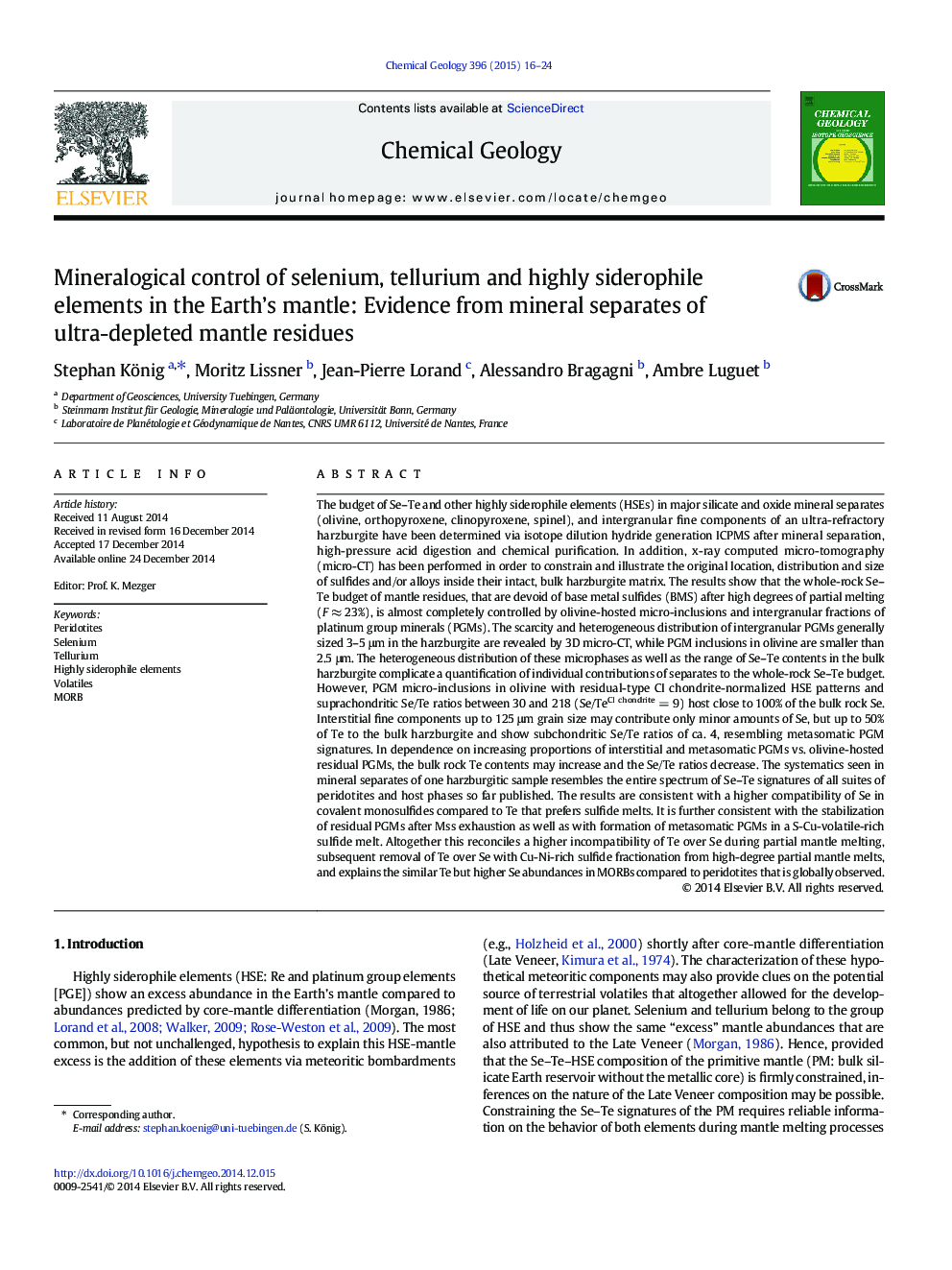| کد مقاله | کد نشریه | سال انتشار | مقاله انگلیسی | نسخه تمام متن |
|---|---|---|---|---|
| 6436498 | 1637577 | 2015 | 9 صفحه PDF | دانلود رایگان |
- First Se-Te analyses of major minerals in an ultra-depleted mantle peridotite.
- Entire bulk harzburgite Se-Te controlled by PGMs.
- Suprachondritic Se/Te in residual, olivine-hosted PGMs.
- Subchondritic Se/Te in interstitial, metasomatic PGMs.
- Further constraints on Se-Te behavior in the Earth's mantle.
The budget of Se-Te and other highly siderophile elements (HSEs) in major silicate and oxide mineral separates (olivine, orthopyroxene, clinopyroxene, spinel), and intergranular fine components of an ultra-refractory harzburgite have been determined via isotope dilution hydride generation ICPMS after mineral separation, high-pressure acid digestion and chemical purification. In addition, x-ray computed micro-tomography (micro-CT) has been performed in order to constrain and illustrate the original location, distribution and size of sulfides and/or alloys inside their intact, bulk harzburgite matrix. The results show that the whole-rock Se-Te budget of mantle residues, that are devoid of base metal sulfides (BMS) after high degrees of partial melting (F â 23%), is almost completely controlled by olivine-hosted micro-inclusions and intergranular fractions of platinum group minerals (PGMs). The scarcity and heterogeneous distribution of intergranular PGMs generally sized 3-5 μm in the harzburgite are revealed by 3D micro-CT, while PGM inclusions in olivine are smaller than 2.5 μm. The heterogeneous distribution of these microphases as well as the range of Se-Te contents in the bulk harzburgite complicate a quantification of individual contributions of separates to the whole-rock Se-Te budget. However, PGM micro-inclusions in olivine with residual-type CI chondrite-normalized HSE patterns and suprachondritic Se/Te ratios between 30 and 218 (Se/TeCI chondrite = 9) host close to 100% of the bulk rock Se. Interstitial fine components up to 125 μm grain size may contribute only minor amounts of Se, but up to 50% of Te to the bulk harzburgite and show subchondritic Se/Te ratios of ca. 4, resembling metasomatic PGM signatures. In dependence on increasing proportions of interstitial and metasomatic PGMs vs. olivine-hosted residual PGMs, the bulk rock Te contents may increase and the Se/Te ratios decrease. The systematics seen in mineral separates of one harzburgitic sample resembles the entire spectrum of Se-Te signatures of all suites of peridotites and host phases so far published. The results are consistent with a higher compatibility of Se in covalent monosulfides compared to Te that prefers sulfide melts. It is further consistent with the stabilization of residual PGMs after Mss exhaustion as well as with formation of metasomatic PGMs in a S-Cu-volatile-rich sulfide melt. Altogether this reconciles a higher incompatibility of Te over Se during partial mantle melting, subsequent removal of Te over Se with Cu-Ni-rich sulfide fractionation from high-degree partial mantle melts, and explains the similar Te but higher Se abundances in MORBs compared to peridotites that is globally observed.
Journal: Chemical Geology - Volume 396, 9 March 2015, Pages 16-24
